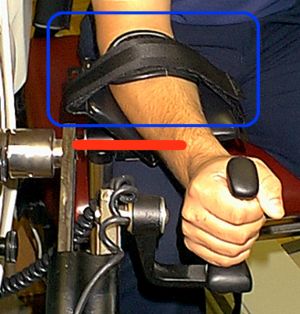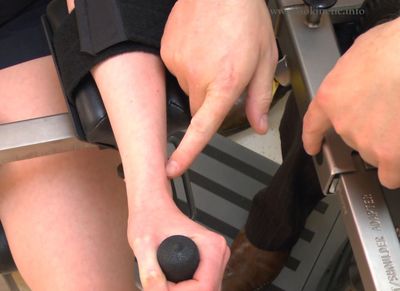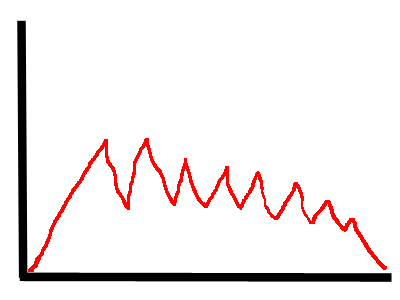Wrist movements do not originate from a single joint. The radius articulates with three of the carple bones (known collectively as the rdiocarple joint) which in turn articulate with each other and the next row of bones (known as the intercarple joints). This allows for radial and ulna deviation (as well as flexion / extension and the combination of all four motions circumduction).
These movements are normally performed in the seated position. Most movements around the wrist in everyday life, and in fact sport, occur with the hand free in space (open chain). The position of the wrist joint moves in space in relation to the elbow which makes the two joints co-dependant.
Seated position:
This position for testing and offers the greatest range of motion. This was the original position of choice for research as the wrist could be more easily stabilized (eventually a V shaped stabiliser was developed to stabilise without altering muscle function). The forearm should be in the middle of pronation and supination for this test. Stabilisation of the upper body with the chest straps often does not limit the motion of the shoulder during the test. The elbow muscles need to be active to resist the pull of the biceps (isometrically). This action is minimal for ulna deviation but will often become much greater in radial deviation. This motion should be discouraged. The arm should be placed at 25 degrees abduction with 90 degrees elbow flexion. Best for research and patient populations.

To view a set up video see below:
Stabilisation:
Seated: in the seated position stabilisation usually involves chest straps, an elbow pad and an elbow strap
Attachments:
The hand grip is always used and should be placed in the neutral position (see seated above) for any test.
Axis of rotation:
The axis of rotation is often difficult. It is located at the centre of the capitate bone (between the styloid processes)

Anatomical zero:
With the wrist parallel to the forearm (see standing position above).
Range of motion:
Although it may be possible to go to extreme radial and ulna deviation. An appropriate range of motion at the wrist would be between 40 degrees radial and 20 degrees ulna deviation.
Gravity correction:
Is necessary, however, a counter balance may be provided to accomplish this.
Speeds:
As velocities in some sports (any involving throwing an object) are known to reach thousands of degrees/second (Pappas et al., 1985) testing using a dynamometer has been said to be non-functional. However, speeds over 300 degrees/second have been found to be difficult to achieve by even baseball pitchers (Cook et al., 1987). This could be said to suggest that muscular effort starts the motion but only occurs at slower speeds with momentum and acceleration playing a larger role later in the speed of the motion later through range rather than pure strength. Even if this speed could be achieved it is over such a small arc that the results gained would likely be fruitless.
Generally it is accepted that speeds of 60 degrees/second and multiples of this should be used.
Wrist Radial / Ulna Deviation Protocols:
Muscles involved:
Flexor & extensor carpi radilis and flexor & extensor carpi ulnaris
| Strength Test Protocols | General | Patients | Athletes | Research |
| Contraction Cycle | con/con | con/con | con/concon/ecc | con/conecc/ecc |
| Speed/s | 60 | 60 | 60-300 | 60-500 |
| Trial Repetitions | 0 | 0 | 0 | 3 |
| Repetitions | 10 | 10 | 10 | 5 |
| Sets | 3 | 3 | 4 | up to 9 |
| Rest between sets | 20-30 secs | 20-30 secs | 20-30 secs | 20 secs |
| Rest between speeds | 2 minutes | 2 minutes | 2 minutes | 2-5 minutes |
| Rest between sides | 5 minutes | 5 minutes | 5 minutes | 5 minutes |
| Feedback | nil | nil | nil | nil |
| Endurance Test Protocols | General | Patients | Athletes | Research |
| Contraction Cycle | con/con | con/con | con/concon/ecc | con/conecc/ecc |
| Speed/s | 90 | 90 | 90-300 | 90-500 |
| Trial Repetitions | 0 | 0 | 0 | 0 |
| Repetitions | Max | Max | Max | Max |
| Sets | 1 | 1 | 1 | 1 |
| Rest between sets | N\A | N/A | N/A | N/A |
| Rest between speeds | 10-15 mins | 10-15 mins | 10-15 mins | 10-30 mins |
| Rest between sides | 5 mins | 5 mins | 5 mins | 5 mins |
| Feedback | nil | nil | nil | nil |
| Strength Exercise Protocol | General | Patients | Athletes |
| Contraction Cycle | con/con | con/con | con/ecc |
| Speed/s | 60 | 60 | 60-300 |
| Trial Repetitions | 0 | 0 | 0 |
| Repetitions | 10 | 10 | 14 |
| Sets | 6 | 6 | up to 12 |
| Rest between sets | 30-60 secs | 30-60 secs | 30 secs |
| Rest between speeds | 2 mins | 2 mins | 2 mins |
| Rest between sides | Nil | Nil | Nil |
| Feedback | bar | bar | bar |
| Endurance Exercise Protocol | General | Patients | Athletes |
| Contraction Cycle | con/con | con/con | con/con |
| Speed/s | 90 | 90 | 90-300 |
| Trial Repetitions | 0 | 0 | 0 |
| Repetitions | Max | Max | Max |
| Sets | 1-3 | 1 | 1-3 |
| Rest between sets | 5-10 mins | N/A | 5-10 mins |
| Rest between speeds | 10-30 mins | N/A | 10-30 mins |
| Rest between sides | Nil | Nil | Nil |
| Feedback | bar/pie chart | bar/pie chart | bar/pie chart |
Notes:
Test the uninvolved or dominant limb first.
Very small ranges of motion may necessitate slower speed.
Interpretation:
In the wrist it is normal to look at the ratio between the right and left sides there should be a 0-10% difference between the sides. Anything beyond this would either demonstrate extreme hand dominance (this can happen in certain sports like javelin), or indicate a muscle imbalance which would be best corrected.
Eccentric results are generally 30% higher than concentric within the same muscle Ivey et al (1985) Davies (1984).
Generally the radial deviators are stronger than the ulna deviators by 30% however results do vary between 50% stronger to 10% stronger
Tennis elbow or lateral epicondylitis (epicondylopathy):
The curve tends to be very erratic due to pain inhibition. The eccentric strength decreases first followed by the concentric strength. Patients often only address the problem when the concentric strength has started to reduce. This type of curve will normally ‘smooth out’ as the problem resolves.
Concentric radial deviation shown

Normative values:
| VanSwearinggen (1983) | M/F | 22 yrs | DomiantRad Dev | Non DominantRad dev | DominatUnla dev | Non DominantUlna dev |
| 60 degs sec PT ftlbs | 7.5 | 6.5 | 5.6 | 5.5 |